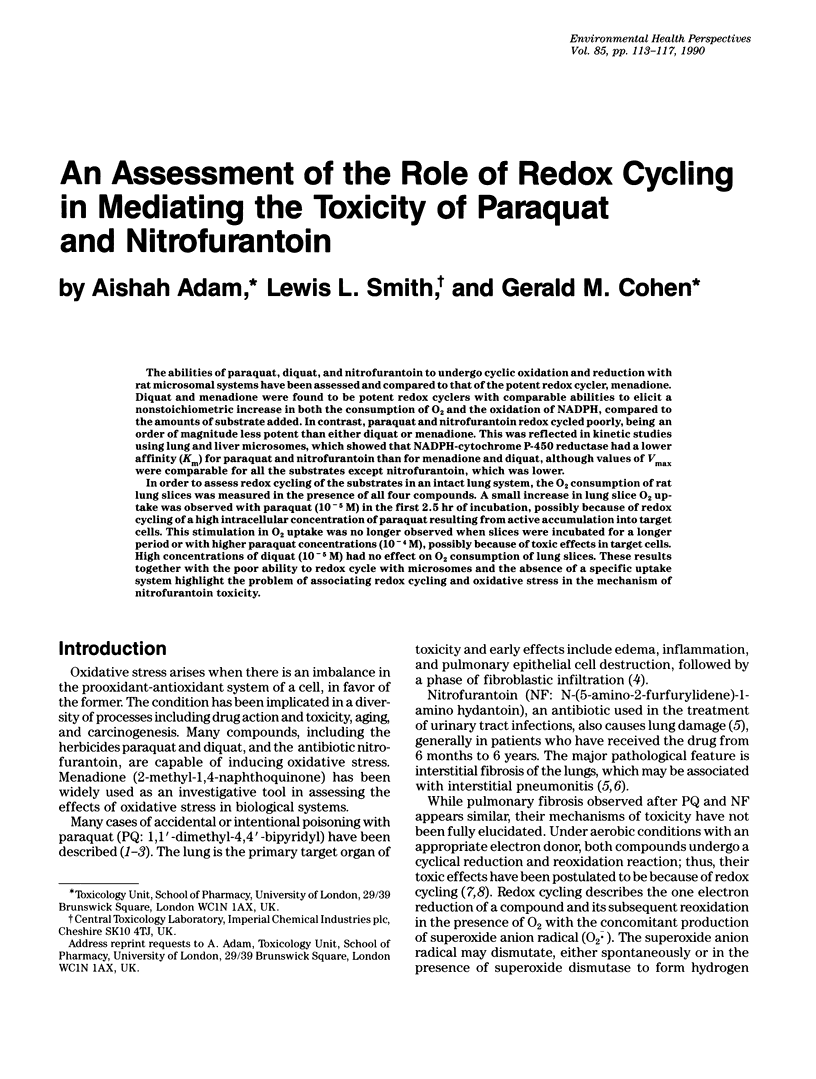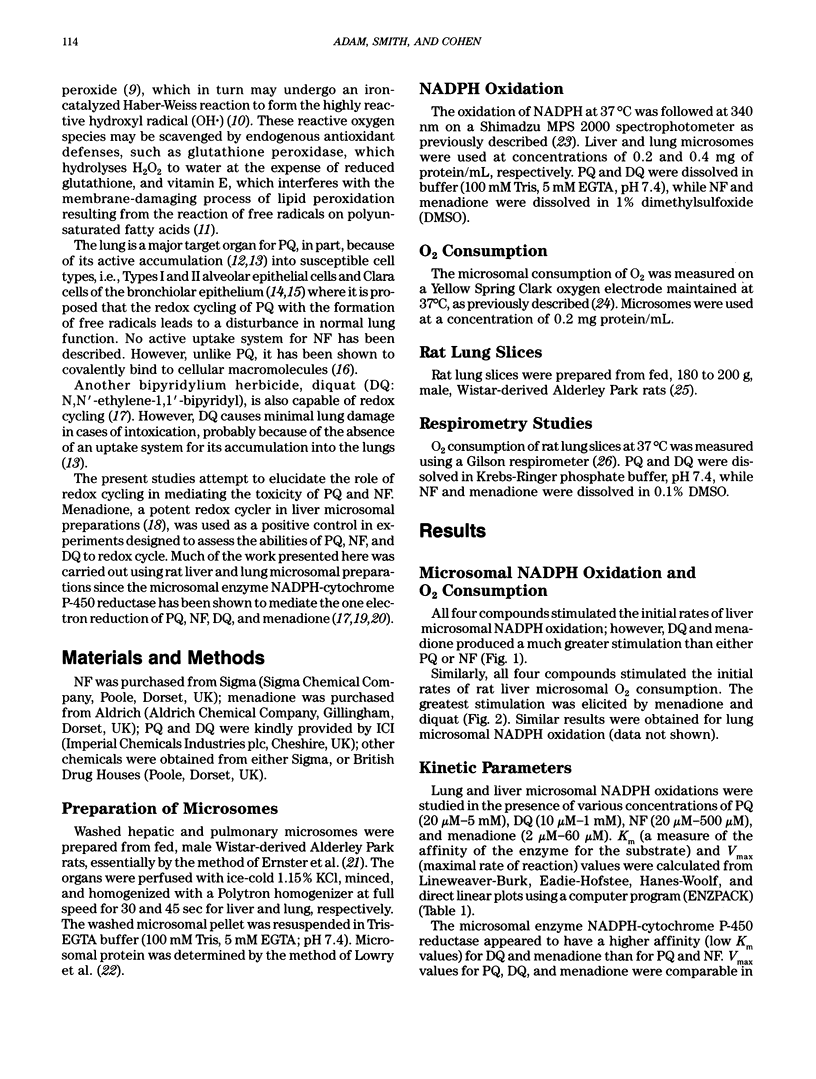Abstract
The abilities of paraquat, diquat, and nitrofurantoin to undergo cyclic oxidation and reduction with rat microsomal systems have been assessed and compared to that of the potent redox cycler, menadione. Diquat and menadione were found to be potent redox cyclers with comparable abilities to elicit a nonstoichiometric increase in both the consumption of O2 and the oxidation of NADPH, compared to the amounts of substrate added. In contrast, paraquat and nitrofurantoin redox cycled poorly, being an order of magnitude less potent than either diquat or menadione. This was reflected in kinetic studies using lung and liver microsomes, which showed that NADPH-cytochrome P-450 reductase had a lower affinity (Km) for paraquat and nitrofurantoin than for menadione and diquat, although values of Vmax were comparable for all the substrates except nitrofurantoin, which was lower. In order to assess redox cycling of the substrates in an intact lung system, the O2 consumption of rat lung slices was measured in the presence of all four compounds. A small increase in lung slice O2 uptake was observed with paraquat (10(-5) M) in the first 2.5 hr of incubation, possibly because of redox cycling of a high intracellular concentration of paraquat resulting from active accumulation into target cells. This stimulation in O2 uptake was no longer observed when slices were incubated for a longer period or with higher paraquat concentrations (10(-4) M), possibly because of toxic effects in target cells. High concentrations of diquat (10(-5) M) had no effect on O2 consumption of lung slices.(ABSTRACT TRUNCATED AT 250 WORDS)
Full text
PDF




Selected References
These references are in PubMed. This may not be the complete list of references from this article.
- Boyd M. R., Catignani G. L., Sasame H. A., Mitchell J. R., Stiko A. W. Acute pulmonary injury in rats by nitrofurantoin and modification by vitamin E, dietary fat, and oxygen. Am Rev Respir Dis. 1979 Jul;120(1):93–99. doi: 10.1164/arrd.1979.120.1.93. [DOI] [PubMed] [Google Scholar]
- Boyd M. R., Stiko A. W., Sasame H. A. Metabolic activation of nitrofurantoin--possible implications for carcinogenesis. Biochem Pharmacol. 1979 Mar 1;28(5):601–606. doi: 10.1016/0006-2952(79)90142-4. [DOI] [PubMed] [Google Scholar]
- Bullivant C. M. Accidental poisoning by paraquat: Report of two cases in man. Br Med J. 1966 May 21;1(5498):1272–1273. doi: 10.1136/bmj.1.5498.1272. [DOI] [PMC free article] [PubMed] [Google Scholar]
- Bus J. S., Aust S. D., Gibson J. E. Superoxide- and singlet oxygen-catalyzed lipid peroxidation as a possible mechanism for paraquat (methyl viologen) toxicity. Biochem Biophys Res Commun. 1974 Jun 4;58(3):749–755. doi: 10.1016/s0006-291x(74)80481-x. [DOI] [PubMed] [Google Scholar]
- Etherton J. E., Gresham G. A. Early bronchiolar damage following paraquat poisoning in mice. J Pathol. 1979 May;128(1):21–27. doi: 10.1002/path.1711280105. [DOI] [PubMed] [Google Scholar]
- Farrington J. A., Ebert M., Land E. J., Fletcher K. Bipyridylium quaternary salts and related compounds. V. Pulse radiolysis studies of the reaction of paraquat radical with oxygen. Implications for the mode of action of bipyridyl herbicides. Biochim Biophys Acta. 1973 Sep 26;314(3):372–381. doi: 10.1016/0005-2728(73)90121-7. [DOI] [PubMed] [Google Scholar]
- Gant T. W., Rao D. N., Mason R. P., Cohen G. M. Redox cycling and sulphydryl arylation; their relative importance in the mechanism of quinone cytotoxicity to isolated hepatocytes. Chem Biol Interact. 1988;65(2):157–173. doi: 10.1016/0009-2797(88)90052-x. [DOI] [PubMed] [Google Scholar]
- Israel K. S., Brashear R. E., Sharma H. M., Yum M. N., Glover J. L. Pulmonary fibrosis and nitrofurantoin. Am Rev Respir Dis. 1973 Aug;108(2):353–356. doi: 10.1164/arrd.1973.108.2.353. [DOI] [PubMed] [Google Scholar]
- Kappus H., Sies H. Toxic drug effects associated with oxygen metabolism: redox cycling and lipid peroxidation. Experientia. 1981 Dec 15;37(12):1233–1241. doi: 10.1007/BF01948335. [DOI] [PubMed] [Google Scholar]
- Kimbrough R. D., Gaines T. B. Toxicity of paraquat to rats and its effect on rat lungs. Toxicol Appl Pharmacol. 1970 Nov;17(3):679–690. doi: 10.1016/0041-008x(70)90042-6. [DOI] [PubMed] [Google Scholar]
- Kursh E. D., Mostyn E. M., Persky L. Nitrofurantoin pulmonary complications. J Urol. 1975 Mar;113(3):392–395. doi: 10.1016/s0022-5347(17)59490-2. [DOI] [PubMed] [Google Scholar]
- LOWRY O. H., ROSEBROUGH N. J., FARR A. L., RANDALL R. J. Protein measurement with the Folin phenol reagent. J Biol Chem. 1951 Nov;193(1):265–275. [PubMed] [Google Scholar]
- Lim L. O., Bortell R., Neims A. H. Nitrofurantoin inhibition of mouse liver mitochondrial respiration involving NAD-linked substrates. Toxicol Appl Pharmacol. 1986 Jul;84(3):493–499. doi: 10.1016/0041-008x(86)90254-1. [DOI] [PubMed] [Google Scholar]
- Mason R. P., Holtzman J. L. The role of catalytic superoxide formation in the O2 inhibition of nitroreductase. Biochem Biophys Res Commun. 1975 Dec 15;67(4):1267–1274. doi: 10.1016/0006-291x(75)90163-1. [DOI] [PubMed] [Google Scholar]
- Matsubara T., Tochino Y. Electron transport systems of lung microsomes and their physiological functions. I. Intracellular distribution of oxidative enzymes in lung cells. J Biochem. 1971 Dec;70(6):981–991. doi: 10.1093/oxfordjournals.jbchem.a129728. [DOI] [PubMed] [Google Scholar]
- McCord J. M., Fridovich I. Superoxide dismutase. An enzymic function for erythrocuprein (hemocuprein). J Biol Chem. 1969 Nov 25;244(22):6049–6055. [PubMed] [Google Scholar]
- Miller M. G., Rodgers A., Cohen G. M. Mechanisms of toxicity of naphthoquinones to isolated hepatocytes. Biochem Pharmacol. 1986 Apr 1;35(7):1177–1184. doi: 10.1016/0006-2952(86)90157-7. [DOI] [PubMed] [Google Scholar]
- Rose M. S., Lock E. A., Smith L. L., Wyatt I. Paraquat accumulation: tissue and species specificity. Biochem Pharmacol. 1976 Feb 15;25(4):419–423. doi: 10.1016/0006-2952(76)90344-0. [DOI] [PubMed] [Google Scholar]
- Rose M. S., Smith L. L., Wyatt I. Evidence for energy-dependent accumulation of paraquat into rat lung. Nature. 1974 Nov 22;252(5481):314–315. doi: 10.1038/252314b0. [DOI] [PubMed] [Google Scholar]
- Rose M. S., Smith L. L., Wyatt I. The relevance of pentose phosphate pathway stimulation in rat lung to the mechanism of paraquat toxicity. Biochem Pharmacol. 1976 Aug 1;25(15):1763–1767. doi: 10.1016/0006-2952(76)90412-3. [DOI] [PubMed] [Google Scholar]
- Smith L. L., Wright A., Wyatt I., Rose M. S. Effective treatment for paraquat poisoning in rats and its relevance to treatment of paraquat poisoning in man. Br Med J. 1974 Dec 7;4(5944):569–571. doi: 10.1136/bmj.4.5944.569. [DOI] [PMC free article] [PubMed] [Google Scholar]
- Tappel A. L. Vitamin E and free radical peroxidation of lipids. Ann N Y Acad Sci. 1972 Dec 18;203:12–28. doi: 10.1111/j.1749-6632.1972.tb27851.x. [DOI] [PubMed] [Google Scholar]
- Thornalley P. J., Doherty M. D., Smith M. T., Bannister J. V., Cohen G. M. The formation of active oxygen species following activation of 1-naphthol, 1,2- and 1,4-naphthoquinone by rat liver microsomes. Chem Biol Interact. 1984 Feb;48(2):195–206. doi: 10.1016/0009-2797(84)90121-2. [DOI] [PubMed] [Google Scholar]
- Vijeyaratnam G. S., Corrin B. Experimental paraquat poisoning: a histological and electron-optical study of the changes in the lung. J Pathol. 1971 Feb;103(2):123–129. doi: 10.1002/path.1711030207. [DOI] [PubMed] [Google Scholar]


